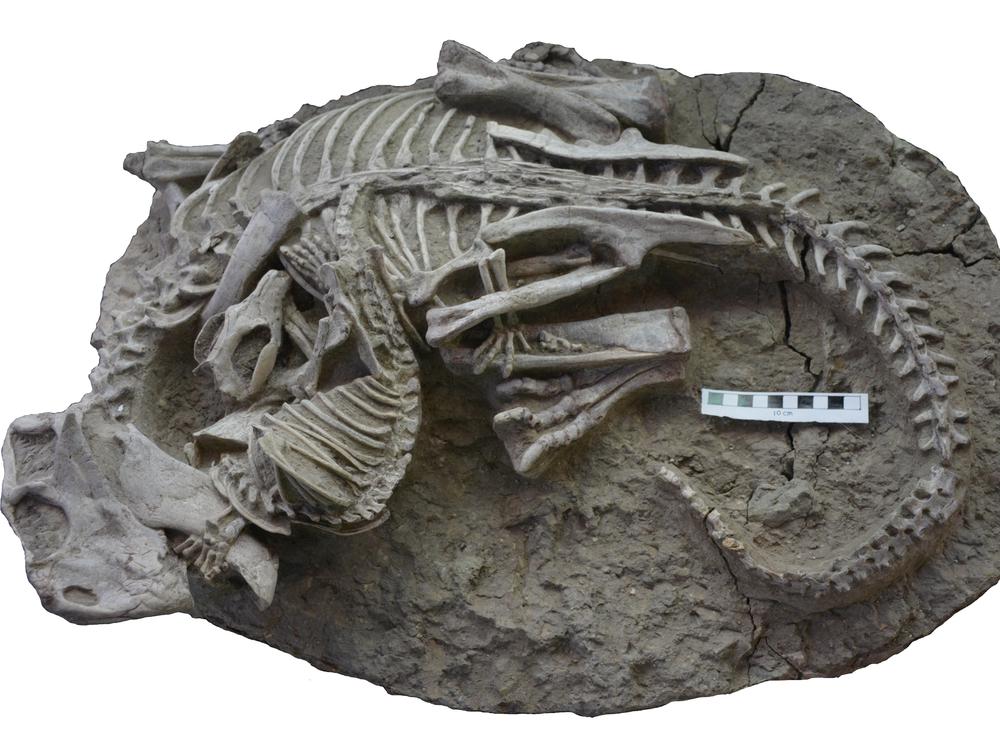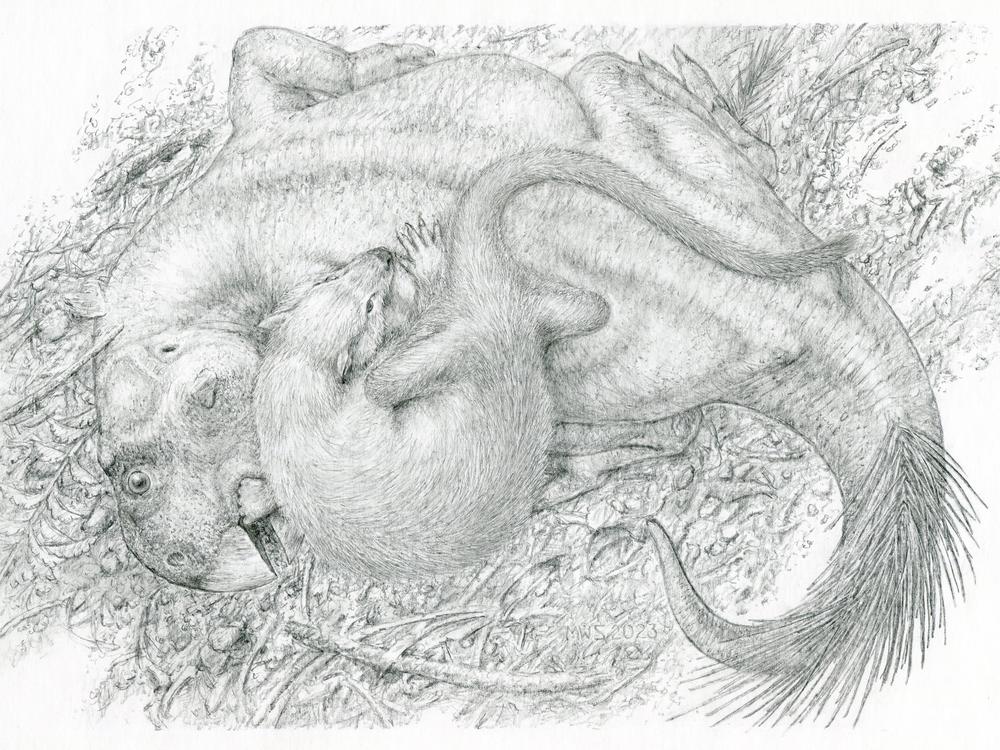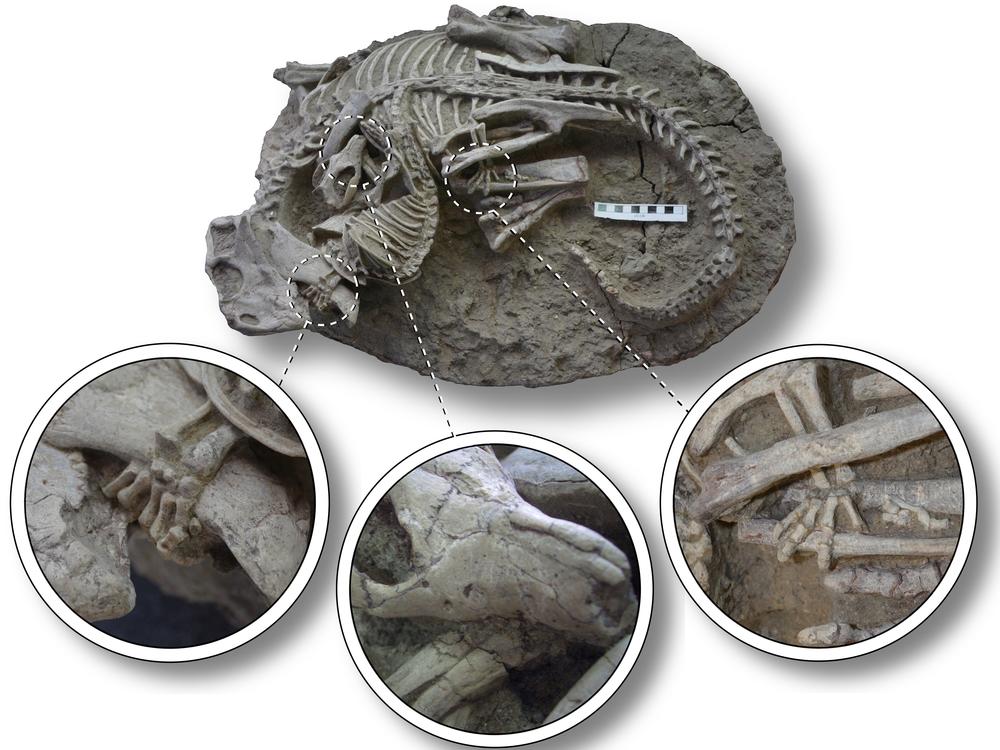Section Branding
Header Content
This fossil of a mammal biting a dinosaur captures a death battle's final moments
Primary Content
When dinosaurs ruled the Earth, we tend to think of the mammals at the time — including our distant ancestors — as small and quivering in the shadows.
"We've always had this picture of mammals as the literal underdogs," says Elsa Panciroli, a paleontologist at the Oxford University Museum of Natural History. "They're being trampled. They're cowering in the darkness at night, just trying to avoid being eaten."
"And that picture of mammals has really persisted until quite recently," she says. "So only in the last 20 years have we started to see that mammals are more diverse in terms of what they do at this time period."
A remarkable new fossil, originating in the early Cretaceous some 125 million years ago and now described in the journal Scientific Reports, also supports this shifting view. It consists of two intertwined skeletons — an upstart mammal sinking its teeth into a much larger dinosaur.
"Our best guess is that the mammal was in the middle of attacking the dinosaur," says Jordan Mallon, one of the authors of the new study and a paleobiologist at the Canadian Museum of Nature.
If true, such a revelation shakes our traditional view of dinosaur domination and mammal submission. It suggests a more complex ancient food web in which certain dinosaurs were prey and some mammals were predators.
In the case of this particular fossil that was unearthed in modern-day northeast China, "this mammal appears to have been particularly gutsy or voracious," Mallon says.
A fossil that tells a story
The fossil is preserved in stunning detail due to the nearby eruption of an ancient volcano, which caused ash and sudden mud flows to preserve everything in the area. They would have buried the early horned dinosaur and mammal instantly, Mallon says, in the middle of the attack.
Often, a fossil is a pile of scattered bones. It's rare for a fossil to record a behavior like this because a behavior, unlike a bone, tends to leave no trace.
But here, a story leaps out to Mallon — one of combat preserved in rock.
"The dinosaur is called Psittacosaurus," says Mallon, "what we call the 'parrot-beaked dinosaur' because it has a beak much like a parrot for ingesting plant matter. It was about the size of a small to medium-sized dog."
In the fossil, Psittacosaurus is on its side, its skeleton curled in a semicircle. Tucked up against the dinosaur is a mammal called Repenomamus, which Mallon calls "maybe a badger-sized animal."
Repenomamus was among the largest mammals of its day. But it's only a third the size of Psittacosaurus.
Mallon points to the way that one of the mammal's paws is clutching the dino's lower jaw, while another grips a hind leg. "And the lower jaw of the mammal is biting onto some of the dinosaur's ribcage," he says.
For Mallon and his Chinese and Canadian colleagues, the conclusion is clear — Repenomamus was attacking an herbivorous dinosaur three times its size.
'An ecosystem full of ninjas'
Elsa Panciroli, who wasn't involved in the research, isn't ready to commit to that conclusion.
"The jury might be out a little bit for me as to whether the dinosaur had already died, maybe only just recently," she says, "or was in a very, very weakened state rather than it having been hunted down by this mammal."
The study authors say that the mammal wasn't scavenging the dinosaur because its bones have no bite marks. And they say that the position of the bodies suggests an active attack was in progress.
"We already knew that mammals did occasionally prey on at least baby dinosaurs," says Mallon. "What's new here is even a fully grown Psittacosaurus wasn't necessarily safe from these smaller mammalian predators."
And Mallon points to other modern-day analogs of smaller animals attacking and preying upon larger ones: a wolverine taking down a caribou "if it's desperate," or a ferret attacking a larger hare.
Regardless of the interpretation of the fossil, Panciroli says it bears witness to a more elaborate Cretaceous food web. "It's just a lot more complex and rich than that oversimplified narrative that we used to rely on."
It's unlikely that this kind of interaction — of a smaller mammal attacking a larger dinosaur — was all that common. Usually, it was the dinosaurs gobbling up the mammals.
"It was almost like, an ecosystem full of ninjas," says Mallon, referring to raptor dinosaurs like Daliansaurus, Graciliraptor and Sinovenator.
That's what makes this particular specimen all the more special.
"These fossilized moments in time," says Mallon, "really allow us to make these quantum leaps in our inferences to be able to reconstruct these ancient ecosystems."
Copyright 2023 NPR. To see more, visit https://www.npr.org.



